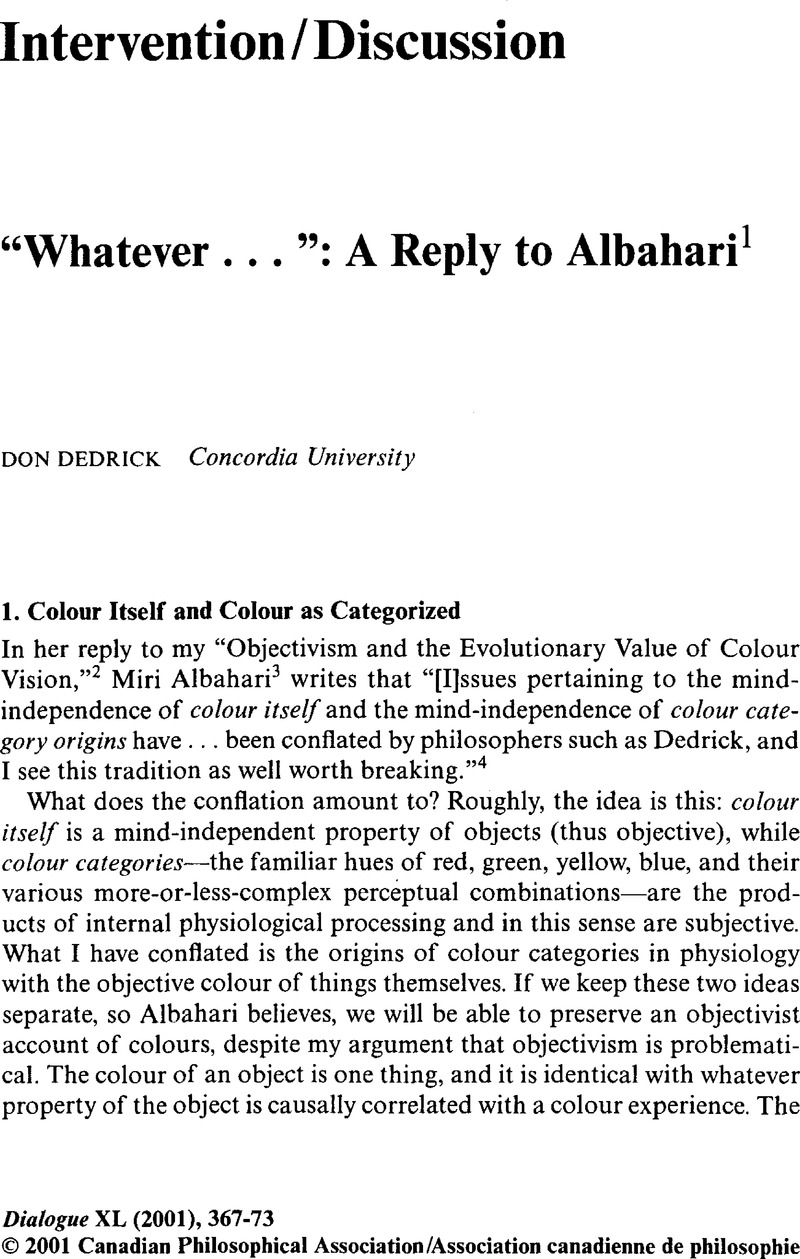No CrossRef data available.
Published online by Cambridge University Press: 13 April 2010

2 Dedrick, Don, “Objectivism and the Evolutionary Value of Colour Vision,” Dialogue, 34 (1995): 35–44CrossRefGoogle Scholar.
3 Albahari, Miri, “Objective Colours and Evolutionary Value: A Reply to Dedrick,” Dialogue, 38 (1999): 99–108CrossRefGoogle Scholar.
4 Ibid., p. 102.
5 Ibid.
6 Ibid., pp. 102-103.
7 Albahari cites Jackson and Pargetter's “particularly clear account” (p. 103) of how subjectivism gets it wrong (Jackson, Frank and Pargetter, Robert, “An Objectivist's Guide to Subjectivism about Colour,” Revue Internationale de Philosophie, 41 (1987): 127–41)Google Scholar. Like Albahari, Jackson and Pargetter assert that “Redness is the property of objects that causes them to look red” (as quoted in Albahari, “Objective Colours and Evolutionary Value,” p. 103). Like Albahari, they have been criticized for begging the question. Boghossian and Velleman write: “Some may contend that if there is a physical property that's distinctive of red-looking objects, then it will inevitably be the property that's attributed to objects by their looking red. But this contention simply assumes that the content of colour experience is determined in a way that's conducive to the truth of physicalism about color-which should not be assumed from the outset” (Boghossian, Paul and Velleman, David, “Physicalist Theories of Colour,” reprinted in Readings on Color, Vol. 1: The Philosophy of Color, edited by Byrne, A. and Hilbert, D. R. [Cambridge, MA: MIT, 1997], p. 132)Google Scholar. Albahari's critique of my views on the function and content of chromatic perceptual states-which I do not discuss in this article-is similar. She claims that the function of colour vision is to detect whatever mind-independent property is conducive to adaptation. In the original article I argued that colour vision need not have the biological function of representing surface reflectance, or any other mind-independent property. Why not? Because “It is the discriminability of colours and their relative ecological stability that is important to an organism, not their grounding in an independently existing property” (Dedrick, , “Objectivism and the Evolutionary Value of Colour Vision,” p. 43)Google Scholar. While I may be wrong about this, it will not do to simply assert that this non-objectivist view of colour's biological function is mistaken. What is adaptive cannot be settled by appeal to objectivist intuitions-so I argued in the original article.
8 Albahari, , “Objective Colours and Evolutionary Value,” p. 103Google Scholar.
9 There are experienced colours that do not have any straightforward objective colour correlates: those experienced in dreams, those produced by rubbing the eyes, or by cortical stimulation. Some implications of these colour causes are discussed in Section 2.
10 Ibid., p. 103.
11 Albahari claims that the determinate/determinable distinction does not precisely apply but corresponds “in some way” (Ibid., p. 107, n.14). That is because her distinction is between colour and “the categorization of colours” (Ibid.). Since she herself does not explain the sense in which the distinction is inadequate, I may be in error in applying it to her view. A few comments on why I do so. Many philosophers have utilized versions of the determinable/ determinate distinction to clarify talk about colour (recently: Hardin, C. L., “Reinverting the Spectrum,” in Readings on Color, Vol. 1: The Philosophy of Color (see note 7), p. 296Google Scholar; A. Byrne and D. R. Hilbert, “Colors and Reflectances” (in Ibid., pp. 280-81). This sort of distinction is useful because it allows one to specify the ways in which a single colour sample may belong to different classes and figure into different generalizations. A sample that is said to be and is red (in some colloquial sense) is thus a sample of colour and a sample of the red colour category (where the latter is a much restricted, i.e., more determinate instance of colour). It is also, to place a further restriction, a determinate shade of red (specifiable, let us say, with precise hue, saturation, and brightness [HSB] coordinates mapping it into a location in a colour quality space). While this nesting of less-to-more determinate classifications may seem obvious, it is easy to lose track of the distinct memberships and generalizations that this sort of distinction captures when using an essentially vague word or concept such as red. Hardin (“Reinverting the Spectrum,” p. 296) remarks that he once believed in a certain perceptual possibility that he now rejects (a “good,” or, as is said, “focal” yellow that is not a light-yellow) because he was “insufficiently sensitive” to the distinction between the hue category yellow (more determinate) and the focal colour yellow (less determinate than the hue category yellow, but not as determinate as a precise HSB specified sample). Byrne and Hilbert (“Colors and Reflectances,” pp. 280-81) utilize a similar type of nested hierarchy in an attempt to dissolve certain problems for their physicalist theory of colour. With respect to Albahari's case: her sand/sieve analogy proposes that it is colour itself which gets sorted-into more determinate colour categories such as red. While it is useful for her to speak of the categorization of colours rather than the colours categorized-because she wants, quite rightly, to focus on my appeal to physiological mechanisms, this should not prevent the above version of a less determinable/more determinate distinction from applying to her view. The colours that we experience-and Albahari does want to talk about them-are not only the product of a process of categorization (for Albahari; I myself would not speak that way) but are also members of colour categories. That is part of what it is to be a “familiar colour” (Albahari, , “Objective Colours and Evolutionary Value,” p. 103)Google Scholar.
12 Ibid.
13 Ibid., p. 107.
14 See, for example, the aforementioned Readings on Color, Vol. 1: The Philosophy of Color, edited by Byrne, and Hilbert, Google Scholar.
15 Hardin, “Reinverting the Spectrum,” p. 300Google Scholar.